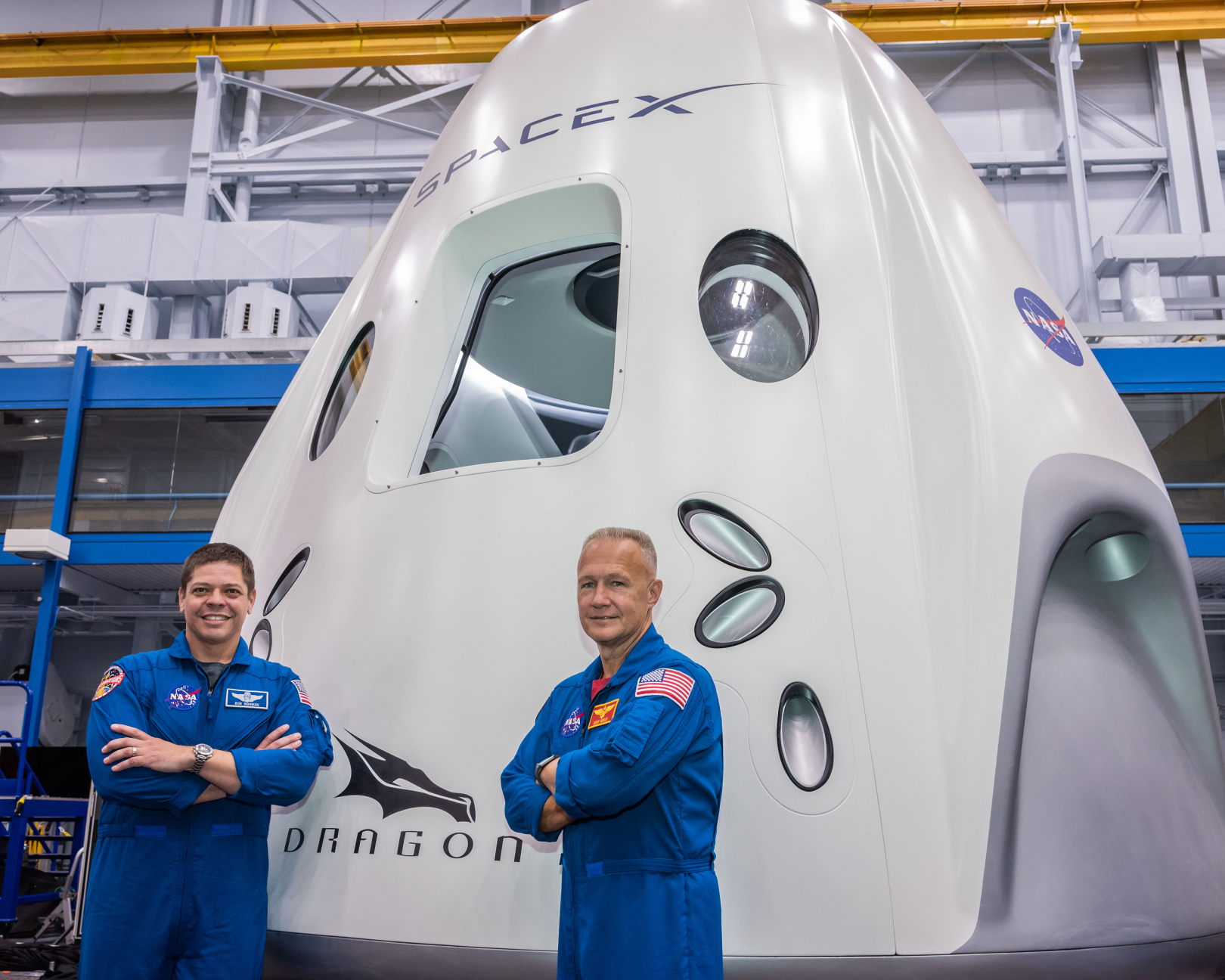
Date:
On May 30, NASA and the commercial rocket company SpaceX will launch the first crewed mission to International Space Station (ISS) from America since 2011. If successful, the SpaceX Demo-2 mission will open the doors on a new era of space exploration.
This mission is the second for the SpaceX Crew Dragon vehicle, but this time it will carry two astronauts to ISS. Doug Hurley and Ben Behnken, both veterans of NASA’s Space Shuttle program, have been preparing for the mission for about two years while SpaceX engineers have been perfecting the Crew Dragon spacecraft’s operation.
The Crew Dragon spacecraft successfully completed its first test mission to ISS without astronauts in March 2019. The cargo version of the Dragon spacecraft has flown to ISS 21 times. This will be the very first time astronauts have flown on SpaceX equipment.
Weather permitting, the SpaceX Demo-2 launch window opens Saturday at 3:22pm EDT. The spacecraft will reach orbit about 8 minutes later and catch up with ISS Sunday morning, docking around 10:30am EDT. Behnken and Hurley will join the ISS expedition 63 crew, remaining aboard for several months. The date for return to Earth for Demo-2 hasn’t been set yet. The NASA mission operations team will use the time to study just how well the Dragon spaceship functioned on the way up to ISS.
Over the past nine years, without our own human-rated launch system, America has depended on our Russian Space Station partners to give us a lift into space. Saturday’s mission will chart an entirely new course for space exploration. This will be the first time NASA astronauts will launch to space in a reusable, non-NASA designed spaceship, launched by a reusable, non-NASA designed rocket. This step will start a new sequence of NASA-driven space operations that will lead to an additional crew capsule provided by the Boeing Corporation, and new rockets built by both SpaceX and United Launch Alliance to lift much heavier payloads into orbit.
The goal of the expansion is to build up our space-based infrastructure and our off-Earth exploration experience to support a long-term human presence on the moon and eventually support the human exploration of Mars.
The key to the next frontier in space exploration though is the evolution of America’s space program. Our program must transition from a 20th century government agency hold-over into a forward-leaning, broadly collaborative effort of the 21st century with a much longer-term and broader vision of exploration. It has to become a program in which innovative technologies, like reusable rockets, can come from independent space companies and where funding is exempt from political whim and influence. For sure, this launch represents a new opportunity for NASA to re-establish itself as a leader in human space exploration. It’s the chance NASA’s needed for a decade to re-capture the public’s imagination of a bold future and exciting future in space. The SpaceX Demo-2 mission is just what the doctor ordered to ignite the imagination of youth to pursue STEM education so that they might choose to become part of the next generation of space explorers.
While the success of the mission will focus on the performance of the new Dragon spaceship to safely carry the astronauts to and from ISS, at the same time, a cohort of ten-year-olds, having never seen astronauts launch from America in their lives, will be dreaming of how in just twenty years’ time, they might be aboard a rocket, bound for the mountains and valleys of Mars. Watch this mission through their eyes if you can. Their imagination rides into the future with those astronauts.
Launch Schedule:
Saturday, May 30
11 a.m. – NASA TV launch coverage begins (continues through docking)
3:22 p.m. – Liftoff
4:09 p.m. – Crew Dragon phase burn
4:55 p.m. – Far-field manual flight test
5:55 p.m. – Astronaut downlink event from Crew Dragon
6:30 p.m. – Postlaunch news conference at Kennedy
- Administrator Bridenstine
- Kathy Lueders, manager, NASA Commercial Crew Program
- SpaceX representative
- Kirk Shireman, manager, International Space Station Program
- NASA Chief Astronaut Pat Forrester
Sunday, May 31
6:45 a.m. – Astronaut downlink event from Crew Dragon
10:29 a.m. – Docking
12:45 p.m. – Hatch Open
1:05 p.m. – Welcome ceremony
3:15 p.m. – Post-arrival news conference at Johnson
- NASA Administrator Jim Bridenstine
- Johnson Space Center Director Mark Geyer
- NASA Chief Astronaut Pat Forrester
Monday, June 1
11:15 a.m. – Space Station crew news conference, with NASA astronauts Chris Cassidy, Bob Behnken, and Doug Hurley
12:55 p.m. – SpaceX employee event and Class of 2020 Mosaic presentation, with NASA astronauts Chris Cassidy, Bob Behnken, and Doug Hurley
To follow the SpaceX Demo-2 mission in real time:
Nasa.gov: Stream starts at 11:00a EDT on Saturday. Follows through the launch and tomorrow’s docking and hatch opening events.
Spacex.com: Coverage starts today at 11:00a EDT on Saturday.
NASA Overview of SpaceX Demo-2 Mission.
Learn about the SpaceX Falcon 9 reusable rocket.
Test your skill at docking Dragon Crew spaceship at ISS. This is the control interface that would be used by the Dragon crew if they were to dock at ISS manually. The standard configuration for docking is auto-pilot controlled docking.


